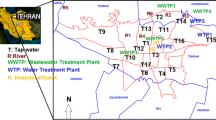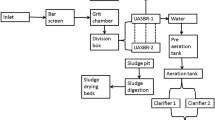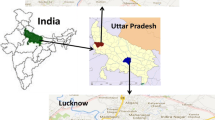Abstract
Pharmaceutical concentration data for Indian surface waters are currently scarce. Sewage often enters Indian rivers without prior treatment, and so previously reported environmental concentrations from regions with routinely implemented sewage treatment cannot simply be used to predict concentrations in Indian surface water. Improved knowledge of pharmaceutical concentrations in Indian waters would enable determination of potential risks posed to aquatic wildlife and human health in this region. The concentrations of five common non-steroidal anti-inflammatory drugs (NSAIDs; diclofenac, ketoprofen, naproxen, ibuprofen, and acetylsalicylic acid) were determined in surface waters from 27 locations of the Kaveri, Vellar, and Tamiraparani Rivers in southern India. The samples were extracted by solid-phase extraction and analyzed by GC-MS. The measured concentrations of four of the five drugs in this reconnaissance were relatively similar to those reported elsewhere (ND–200 ng/l); however, acetylsalicylic acid, the most readily degradable of the investigated drugs, was found at all sites and at considerably higher concentrations (up to 660 ng/l) than reported in European surface waters. This is the first report on the occurrence of NSAIDs in Indian rivers. The finding of elevated concentrations of acetylsalicylic acid is most likely a result of direct discharges of untreated sewage. Therefore, readily degradable pharmaceuticals may present larger concern in regions without consistent sewage treatment. Based on measured environmental concentrations, the risks of direct toxicity to aquatic wildlife and of humans consuming the water are discussed.


Similar content being viewed by others
References
American Public Health Association (1998) Standard methods for the examination of water and waste water. American Public Health Association, Washington
Aydin E, Talinli I (2013) Analysis, occurrence and fate of commonly used pharmaceuticals and hormones in the Buyukcekmece watershed, Turkey. Chemosphere 90:2004–2012
Baranowska I, Kowalski B (2011) Using HPLC method with DAD detection for the simultaneous determination of 15 drugs in surface water and wastewater. Polish J Environ stud 20:21–28
Behera SK, Kim HW, Oh JE, Park HS (2011) Occurrence and removal of antibiotics, hormones and several other pharmaceuticals in wastewater treatment plants of the largest industrial city of Korea. Sci Total Environ 409:435–4360
Brown JN, Paxeus N, Forlin L, Larsson DGJ (2007) Variations in bioconcentration of human pharmaceuticals from sewage effluents into fish blood plasma. Environ Toxicol Pharmacol 2:267–274
Brun GL, Bernier M, Losier R, Doe K, Jackman P, Lee HB (2006) Pharmaceutically active compounds in Atlantic Canadian sewage treatment plant effluents and receiving waters, and potential for environmental effects as measured by acute and chronic aquatic toxicity. Environ Toxicol Chem 25:2163–2176
Central Pollution Control Board (1993) Accessed from http://www.hppcb.gov.in/eiasorang/spec.pdf on 04/03/2013
Cleuvers M (2004) Mixture toxicity of the anti-inflammatory drugs diclofenac, ibuprofen, naproxen, and acetylsalicylic acid. Ecotoxicol Environ Saf 59:309–315
Cuklev F, Kristiansson K, Fick J, Asker N, Forlin L, Larsson DGJ (2011) Diclofenac in fish–blood plasma levels similar to human therapeutic levels affect global hepatic gene expression. Environ Toxicol Chem 30:2126–2134
Daneshvar A, Svanfelt J, Kronberg L, Weyhenmeyer G (2012) Neglected sources of pharmaceuticals in river water footprints of a Reggae festival. J Environ Monit 14:596–603
Desbrow C, Routledge EJ, Brighty GC, Sumpter JP, Waldock M (1998) Identification of estrogenic chemicals in STW effluents. 1. Chemical fractionation and in vitro biological screening. Environ Sci Technol 32:1549–1558
Diwan V, Tamhankar AJ, Aggarwal M, Sen S, Khandal RK, Lundborg CS (2009) Detection of antibiotics in hospital effluents in India. Current 97:12–15
European Agency for the Evaluation of Medicinal Products (2006) Committee for Medicinal Products for Human Use Guideline on the environmental risk assessment of medicinal products for human use. Ref EMEA/CRMP/SWP/4447/00. London, UK
European Commission (2003) Technical Guidance Document in Support of Commission Directive 93/67/EEC on Risk Assessment for New Notified Substances and Commission Regulation (EC) No 1488/94 on Risk Assessment for Existing Substances, Part II. Brussels, Belgium
Farre ML, Ferrer I, Ginebreda A, Figueras M, Olivella L, Tirapu L, Vilanova M, Barcelo D (2001) Determination of drugs in surface water and wastewater samples by liquid chromatography-mass spectrometry: methods and preliminary results including toxicity studies with Vibrio fischeri. J Chromatogr A 938:187–197
Ferrari B, Mons R, Vollat B, Fraysse B, Paxeus N, Lo Giudice R, Pollio A, Garric J (2004) Environmental risk assessment of six human pharmaceuticals: are the current environmental risk assessment procedures sufficient for the protection of the aquatic environment? Environ Toxicol Chem 23:1344–1354
Fick J, Soderstrom H, Lindberg RH, Phan C, Tysklind M, Larsson DGJ (2009) Contamination of surface, ground, and drinking water from pharmaceutical production. Environ Toxicol Chem 28:2522–2527
Fick J, Lindberg RH, Tysklind M, Larsson DGJ (2010) Predicted critical environmental concentrations for 500 pharmaceuticals. Regul Toxicol Pharmacol 58:516–523
Fram MS, Belitz K (2011) Occurrence and concentrations of pharmaceutical compounds in groundwater used for public drinking-water supply in California. Sci Total Environ 409:3409–3417
Gros M, Petrovic M, Ginebreda A, Barcelo D (2010) Removal of pharmaceuticals during wastewater treatment and environmental risk assessment using hazard indexes. Environ Int 36:15–26
Gunnarsson L, Jauhiainen A, Kristiansson E, Nerman O, Larsson DGJ (2008) Evolutionary conservation of human drug targets in organisms used for environmental risk assessments. Environ Sci Technol 42:5807–5813
Helenkar A, Sebok A, Zaray G, Molnar Perl I, Vasanits-Zsigrai A (2010) The role of the acquisition methods in the analysis of the non-steroidal anti-inflammatory drugs in Danube river by gas chromatography–mass spectrometry. Talanta 82:600–607
Hernando MD, Mezcua M, Fernandez-Alba AR, Barcelo D (2006) Environmental risk assessment of pharmaceutical residues in wastewater effluents, surface waters and sediments. Talanta 69:334–342
Ji K, Liu X, Lee S, Kang S, Kho Y, Giesy JP, Choi K (2013) Effects of non-steroidal anti-inflammatory drugs on hormones and genes of the hypothalamic-pituitary-gonad axis, and reproduction of zebrafish. J Hazard Mater 254–255:242–251
Kidd KA, Blanchfield PJ, Mills KH, Palace VP, Evans RE, Lazorchak JM, Flick RW (2007) Collapse of a fish population after exposure to a synthetic estrogen. Proc Natl Acad Sci USA 104:8897–8901
Kamala K, Dinesh Kumar B (2006) Drug consumption pattern in urban and rural areas of India and their health implications. Proceedings of symposium on primary health care—new initiatives. Nutrition Foundation of India, New Delhi, pp 140–148
Kim JW, Jang HS, Kim JG, Ishibashi H, Hirano M, Nasu K (2009) Occurrence of pharmaceutical and personal care products (PPCPs) in surface water from Mankyung River, South Korea. J Health Sci 55:249–258
Komori K, Suzuki Y, Minamiyama M, Harada A (2012) Occurrence of selected pharmaceuticals in river water in Japan and assessment of their environmental risk. Environ Monit Assess. doi:10.1007/s1066101228864
Koreje K, Demeestere K, Wispelaere PD, Vergeynst L, Dewulf J, Langenhove HV (2012) From multiresidue screening to target analysis of pharmaceuticals in water: development of a new approach based on magnetic sector mass spectrometry and application in the Nairobi River basin, Kenya. Sci Tot Environ 437:153–164
Kosjek T, Heath E, Krbavcic A (2005) Determination of non-steroidal anti-inflammatory drug (NSAIDs) residues in water samples. Environ Inter 31:679–685
Kristiansson E, Fick J, Janzon A, Grabic R, Rutgersson C, Weijdegard B, Soderstrom H, Larsson DGJ (2011) Pyrosequencing of antibiotic-contaminated river sediments reveals high levels of resistance and gene transfer elements. PLoS One 6:e17038
Larsson DGJ, Adolfsson-Erici M, Parkkonen J, Pettersson M, Berg H, Olsson PE, Forlin L (1999) Ethinyloestradiol—an undesired fish contraceptive? Aquat Toxicol 45:91–97
Larsson DGJ, de Pedro C, Paxeus N (2007) Effluent from drug manufactures contains extremely high levels of pharmaceuticals. J Hazard Mater 148:751–755
Lin AY, Yu TH, Lateef SK (2009) Removal of pharmaceuticals in secondary wastewater treatment processes in Taiwan. J Hazard Mater 167:1163–1169
Lin AYC, Panchangam SC, Chen HY (2010) Implications of human pharmaceutical occurrence in the Sindian river of Taiwan: a strategic study of risk assessment. J Environ Monit 12:261–270
Mehinto AC, Hill EM, Tyler CR (2010) Uptake and biological effects of environmentally relevant concentrations of the nonsteroidal anti-inflammatory pharmaceutical diclofenac in rainbow trout (Oncorhynchus mykiss). Environ Sci Technol 44:2176–2182
Memmert U, Peither A, Burri R, Weber K, Schmidt T, Sumpter JP (2013) Diclofenac: new data on chronic toxicity and bioconcentration in fish. Environ Toxicol Chem 32:442–452
Meyer B, Pailler JY, Guignard C, Hoffmann L, Krein A (2011) Concentrations of dissolved herbicides and pharmaceuticals in a small river in Luxembourg. Environ Monit Assess 180:127–146
Moldovan Z (2006) Occurrences of pharmaceutical and personal care products as micropollutants in rivers from Romania. Chemosphere 64:1808–1817
Oaks JL, Gilbert M, Virani MZ, Watson RT, Meteyer CU, Rideout BA, Shivaprasad HL, Ahmed S, Chaudhry MJI, Arshad M, Mahmood S, Ali A, Khan AA (2004) Diclofenac residues as the cause of vulture population decline in Pakistan. Nature 427:630–633
Patrolecco L, Ademollo N, Grenni P, Tolomei A, Barra Caracciolo A, Capri S (2013) Simultaneous determination of human pharmaceuticals in water samples by solid phase extraction and HPLC with UV-fluorescence detection. Microchem J 107:165–171
Paul AD, Chauhan CK (2005) Study of usage pattern of nonsteroidal anti-inflammatory drugs (NSAIDs) among different practice categories in Indian clinical setting. Eur J Clin Pharmacol 60:889–892
Peng X, Yu Y, Tang C, Tan J, Huang Q, Wang Z (2008) Occurrence of steroid estrogens, endocrine-disrupting phenols, and acid pharmaceutical residues in urban riverine water of the Pearl River Delta, South China. Sci Total Environ 397:158–166
Quinn B, Gagne F, Blaise C (2008) An investigation into the acute and chronic toxicity of eleven pharmaceuticals (and their solvents) found in wastewater effluent on the cnidarians, Hydra attenuata. Sci Total Environ 389:306–314
Ramaswamy BR, Shanmugam G, Velu G, Rengarajan B, Larsson DGJ (2011) GC-MS analysis and ecotoxicological risk assessment of triclosan, carbamazepine and parabens in Indian Rivers. J Hazard Mater 186:1586–1593
Sanchez-Prado L, Garcia-Jares C, Llompart M (2010) Microwave-assisted extraction: application to the determination of emerging pollutants in solid samples. J Chromatogr A 1217:2390–2414
Santos JL, Aparicio I, Alonso E (2007) Occurrence and risk assessment of pharmaceutically active compounds in wastewater treatment plants. A case study: Seville city (Spain). Environ Int 33:596–601
Santos JL, Aparicio I, Callejon M, Alonso E (2009) Occurrence of pharmaceutically active compounds during 1-year period in wastewaters from four wastewater treatment plants in Seville (Spain). J Hazard Mater 164:1509–1516
Scheurell M, Franke S, Shah RM, Huhnerfuss H (2009) Occurrence of diclofenac and its metabolites in surface water and effluent samples from Karachi, Pakistan. Chemosphere 77:870–876
Schwaiger J, Ferling H, Mallow U, Wintermayr H, Negele RD (2004) Toxic effects of the non-steroidal anti-inflammatory drug diclofenac. Part I. Histopathological alterations and bioaccumulation in rainbow trout. Aquat Toxicol 68:141–150
Selke S, Scheurell M, Raza M, Hühnerfuss H (2010) Identification and enantioselective gas chromatographic mass-spectrometric separation of O-desmethylnaproxen, the main metabolite of the drug naproxen, as a new environmental contaminant. J Chromatogr A 1217:419–423
Shanmugam G, Ramaswamy BR, Radhakrishnan V, Tao H (2010) GC-MS method for the determination of paraben preservatives in the human breast cancerous tissue. Microchem J 96:391–396
Silva BFD, Jelic A, Lopez Serna R, Mozeto AA, Petrovic M, Barcelo D (2011) Occurrence and distribution of pharmaceuticals in surface water, suspended solids and sediments of the Ebro river basin, Spain. Chemosphere 85:1331–1339
Sim WJ, Lee JW, Oh JE (2010) Occurrence and fate of pharmaceuticals in wastewater treatment plants and rivers in Korea. Environ Pollut 158:1938–1947
Sousa MA, Goncalves C, Cunha E, Hajslova J, Alpendurada MF (2011) Cleanup strategies and advantages in the determination of several therapeutic classes of pharmaceuticals in wastewater samples by SPE–LC–MS/MS. Anal Bioanal Chem 399:807–822
Suarez S, Lema JM, Omil F (2010) Removal of pharmaceutical and personal care products (PPCPs) under nitrifying and denitrifying conditions. Water Res 44:3214–3224
Ternes T, Bonerz M, Schmidt M (2001) Determination of neutral pharmaceuticals in wastewater and rivers by liquid chromatography–electrospray tandem mass spectrometry. J Chromatogr A 938:175–185
Thorpe KL, Cummingsm RI, Tutchinson TH, Scholz M, Brighty G, Sumpter JP (2003) Relative potencies and combination effects of steroidal estrogens in fish. Environ Sci Technol 37:1142–1149
Togola A, Budzinski H (2007) Analytical development for analysis of pharmaceuticals in water samples by SPE and GC-MS. Anal Bioanal Chem 388:627–635
Triebskorn R, Casper H, Heyd A, Eikemper R, Kohler HR, Schwaiger J (2004) Toxic effects of the non-steroidal anti-inflammatory drug diclofenac. Part II: Cytological effects in liver, kidney, gills and intestine of rainbow trout (Oncorhynchus mykiss). Aquat Toxicol 68:151–166
Vulliet E, Cren-Olive C (2011) Screening of pharmaceuticals and hormones at the regional scale, in surface and groundwaters intended to human consumption. Environ Pollut 159:292–2934
Vystavna Y, Huneau F, Grynenko V, Vergeles Y, Celle-Jeanton H, Tapie N, Budzinski H, Coustumer PL (2012) Pharmaceuticals in rivers of two regions with contrasted socio-economic conditions: occurrence, accumulation, and comparison for Ukraine and France. Water Air Soil Pollut 223:2111–2124
Webb S, Ternes T, Gibert M, Olejniczak K (2003) Indirect human exposure to pharmaceuticals via drinking water. Toxicol Lett 142:157–167
World Health Organization (2013) Accessed from http://www.whocc.no/atc_ddd_index/ on 04/03/2013
Xu Y, Luo F, Pal A, Gin KY, Reinhard M (2011) Occurrence of emerging organic contaminants in a tropical urban catchment in Singapore. Chemosphere 83:963–969
Yoon Y, Ryu J, Oh J, Choi BG, Snyder SA (2010) Occurrence of endocrine disrupting compounds, pharmaceuticals, and personal care products in the Han River (Seoul, South Korea). Sci Total Environ 408:636–643
Zhang Y, Geissen SU, Gal C (2008) Carbamazepine and diclofenac: removal in wastewater treatment plants and occurrence in water bodies. Chemosphere 73:1151–1161
Zhao JL, Ying GG, Liu YS, Chen F, Yang JF, Wang L, Yang XB, Stauber JL, Warne MS (2010) Occurrence and a screening-level risk assessment of human pharmaceuticals in the Pearl River system, South China. Environ Toxicol Chem 29:1377–1384
Acknowledgments
The authors wish to thank the United Nations University, Tokyo, Japan; SHIMADZU Corporation, Japan for the GC-MS facility established at Bharathidasan University through the project titled, “POPs Monitoring in Asian Coastal Hydrosphere;” and Bharathidasan University. SG is grateful to the University Grant Commission (UGC), New Delhi for the Research Fellowship award through a non-SAP grant to the Department of Environmental Biotechnology, Bharathidasan University, India; the Swedish Research Council; and the Swedish Foundation for Strategic Environmental Research (MISTRA).
Author information
Authors and Affiliations
Corresponding author
Additional information
Responsible editor: Hongwen Sun
Electronic supplementary material
Below is the link to the electronic supplementary material.
ESM 1
(DOC 34 kb)
Rights and permissions
About this article
Cite this article
Shanmugam, G., Sampath, S., Selvaraj, K.K. et al. Non-steroidal anti-inflammatory drugs in Indian rivers. Environ Sci Pollut Res 21, 921–931 (2014). https://doi.org/10.1007/s11356-013-1957-6
Received:
Accepted:
Published:
Issue Date:
DOI: https://doi.org/10.1007/s11356-013-1957-6




